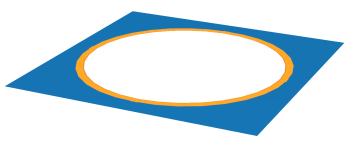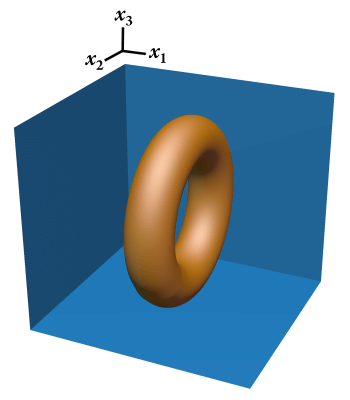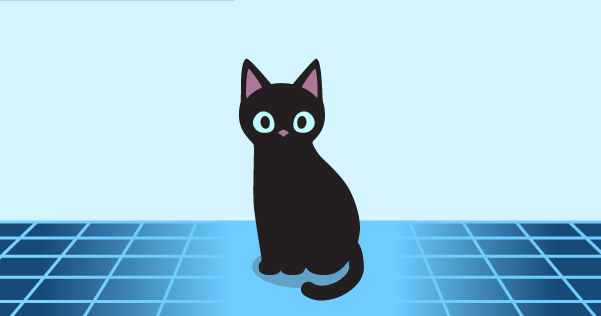Visualizing Knots in Spacetime
In Knot Physics, particles are knots in the spacetime manifold.
Visualizing Knots in Spacetime
In Knot Physics, particles are knots in the spacetime manifold.
In Knot Physics, elementary fermions—like electrons and quarks—are topological defects in the spacetime manifold, which we often refer to as knots.[1] We can think of spacetime as a 3-dimensional manifold that changes over time; as such, the fermions of Knot Physics are topological defects in that 3-dimensional manifold.
To understand their topology, we first consider the 2-dimensional version of these topological defects and then extend the concept to 3 dimensions. We will use a process known as topological surgery, where we take familiar manifolds and then cut and glue them to create the topological defects.
Surgery in 2 Dimensions
We begin with \( \mathbb{R}^2 ,\) which is a 2-dimensional plane. Then we perform a surgical operation by removing a disk \( D^2 \) from the plane. The result of that surgery is called \( \mathbb{R}^2 - D^2 .\)

By removing the disk \( D^2 ,\) we have created a boundary circle. The next step is to take every point on the boundary and attach it to the point that is diametrically opposite to it. It may seem like this would just close the hole that we created by removing the disk, but it actually creates something entirely new: the topological defect \( \mathbb{R}^2 \# P^2 .\) The topological defect \( \mathbb{R}^2 \# P^2 \) is the 2-dimensional version of a fermion.
After this surgery, the manifold no longer fits in 2 dimensions. \( \mathbb{R}^2 \# P^2 \) must be embedded in a space with at least 4 dimensions, otherwise the manifold would intersect itself.
One interesting feature of \( \mathbb{R}^2 \# P^2 \) is that a strip through the center has a ½ twist. As such, we could cut a strip from this manifold such that it is a Möbius strip.
Surgery in 3 Dimensions
We used surgery in 2 dimensions to create \( \mathbb{R}^2 \# P^2 ,\) the 2-dimensional version of the elementary fermions of Knot Physics. We now create the actual topology of fermions by extending the surgery operation to 3 dimensions.
We begin with \( \mathbb{R}^3 \), a 3-dimensional space. Then we perform a surgical operation by removing a solid torus \( S^1 \times D^2 \) from \( \mathbb{R}^3 \) to create a boundary torus. The result is \( \mathbb{R}^3 - (S^1 \times D^2) .\)

We can think of the boundary torus as being made of many circles. Previously, we used the boundary circle of \( \mathbb{R}^2 - D^2 \) to make \( \mathbb{R}^2 \# P^2 .\) Now, we perform that same surgery on the circles of the boundary torus: We attach each point on each circle to the point that is diametrically opposite to it. The result of that surgery is \( \mathbb{R}^3 \# (S^1 \times P^2) .\) After this surgery, the manifold must be embedded in a space with at least 5 dimensions; anything less than that would cause the manifold to intersect itself.
On the left, we show the dimensions \((x_1,x_2,x_3).\) We see the boundary torus of \( \mathbb{R}^3 - (S^1 \times D^2) \) contracting as we attach each point on each circle of the torus to the point that is diametrically opposite to it.
On the right, instead of showing dimension \(x_3,\) we show dimension \(x_4.\) We see a slice of \( \mathbb{R}^3 - (S^1 \times D^2) ,\) a plane with a disk removed. Each point on the boundary circle attaches to the point that is diametrically opposite to it, creating a topological defect. This occurs for every boundary circle on the boundary torus.
By performing this topological surgery in 3 dimensions, we have created the topology of a fermion: \( \mathbb{R}^3 \# (S^1 \times P^2) .\)
In Knot Physics, spacetime is a 4-dimensional manifold (3 spatial dimensions + 1 time dimension) embedded in a 6-dimensional space (5 spatial dimensions + 1 time dimension). We can think of spacetime as a 3-dimensional manifold that moves around inside of a 5-dimensional space.
We can imagine sitting in the 5-dimensional space and performing surgery on the 3 spatial dimensions of the spacetime manifold. If we were to cut and glue the spacetime manifold in the way that we described here, we would create topological defects of type \( \mathbb{R}^3 \# (S^1 \times P^2) .\) These topological defects are fermions—like electrons and quarks.[2][3]
Notes
- The mathematical theory of knots has a specific definition of the word “knot”: an embedding of an n-dimensional sphere \(S^n\) in an \(n+2\)-dimensional sphere \(S^{n+2}.\) In Knot Physics, we often use the term “knot” instead of “topological defect” for simplicity.
- We have described the topology of an elementary fermion by cutting and gluing a 3-manifold. In reality, fermions are created and annihilated by an entirely different process, but this cutting and gluing process is a helpful way of understanding fermion topology.
- We have discussed the topology of fermions, specifically the homeomorphism class, which is \( \mathbb{R}^3 \# (S^1 \times P^2).\) This type of topological defect can have different embeddings and geometric properties. The variety of embeddings and geometric properties explains the variety of fermion types.
Learn More
Theory Summary
An overview of the entire theory, from simple assumptions about the spacetime manifold through particles, quantum mechanics, and forces
Learn more
Theory Summary
An overview of the entire theory, from simple assumptions about the spacetime manifold through particles, quantum mechanics, and forces
Learn more

